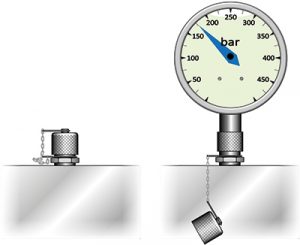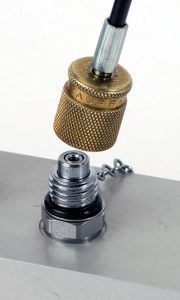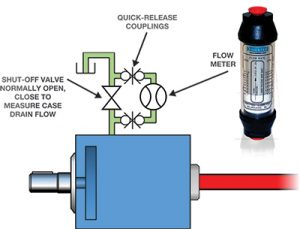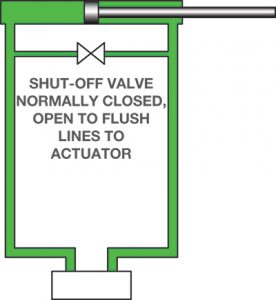When it comes to hydraulic system maintenance, it is vital that the people involved in recording data, taking samples, using test equipment, etc., are properly trained in the jobs they have to perform and the equipment they have to use. No matter how comprehensive the maintenance procedures are, there will inevitably be occasions when maintenance personnel have to use their initiative, so it is important that they are properly equipped to do so.

Figure 1. Pressure test point, above and below
Examples of good maintenance practice include the following:
- Pressure test points. Fit pressure test points into the system where pressure readings are likely to be required (such as when setting pressure-relief or pressure-reducing valves). Gauges permanently connected into the system may be subject to pressure peaks and ripple, and so tend to have a short life. They can be protected by ‘push to read’ or ‘twist to read’ valves, which normally isolate them from the system, or they can be removed completely and only connected when required via simple quick-release test points (see Figure 1).
- Access points. Include access points for taking fluid samples from the system, normally from the pressure line or from the reservoir. Sampling from the reservoir should ideally be via a pipe, taking fluid from the center of the reservoir, away from where water or contamination is likely to settle.
- Flow meters. Flow meters are sometimes permanently connected into systems but more often need to be connected temporarily for test purposes. This process can be made simpler by including quick-release couplings and/or three-way valves to divert flow through the meter when required (Figure 2). Care should be taken, however, to ensure that the test equipment and associated fittings do not create undue restriction (e.g., in the case drain line of pumps and motors).
- Adding new fluid. As stated previously, new fluid to be added to a reservoir will normally require cleaning, so provision should be made to incorporate a filter on the reservoir filling connection. If this is not practical, a filling point should be included so that it is not possible to simply pour fluid into the tank. If filling of the tank has to be carried out by pumping the fluid in (e.g., via a quick-release coupling or side connection), it is more likely to be done correctly via a fluid-transfer cart and filter.
 Label reservoirs. Color code or clearly label each system reservoir with the correct fluid to be used for filling and topping up.
Label reservoirs. Color code or clearly label each system reservoir with the correct fluid to be used for filling and topping up.- Mark normal fluid levels. Mark the normal maximum and minimum fluid levels on the reservoir sight glass.
- Shut-off valves. Where shut-off valves are likely to cause damage if set incorrectly, for example on pump inlet or drain lines, they should be monitored via limit or proximity switches that are interlocked to ensure pumps cannot be started unless the valves are fully open.
- Drain valves. Consider using automatic drain valves on accumulators to drain the pressurized fluid whenever the machine is switched off. Manual valves should also be included (as a back-up), together with an isolated pressure gauge to verify that the accumulators have been discharged.
- Components requiring regular attention. Ensure components requiring regular attention (filters, test points, gauges, etc.) are easily accessible, and that spillage trays are placed where fluid is likely to be spilled during maintenance activities (e.g., changing filter elements).
- Flush valves. Consider adding flushing valves around actuators (Figure 3). This will make the flushing process simpler when the system is first installed and will also be useful when actuator connections involve long pipe runs. In long pipe runs the volume of fluid in the pipe may often be greater than the displacement of a cylinder, so the fluid will just shuttle backwards and forwards along the pipe (i.e., it will never get back to the system cooler, filter or reservoir). A bypass valve around the cylinder can be opened periodically during maintenance periods to flush new oil into that part of the system.
- Make the correct way the easiest way. Adopt the philosophy that the easier it is to do something the more likely it is that it will be done. Also, the correct way of doing something should be made the easiest way of doing it, so that mistakes are less likely to happen.
Handle the unexpected with skilled troubleshooting

Figure 2. Monitoring pump drain line flow
No matter which maintenance methodology is used and how rigorous the process, there will inevitably be occasions when something unexpected occurs to cause a malfunction in a system or of a machine. This is when troubleshooting skills become necessary, to locate the fault as quickly and accurately as possible. So, whereas maintenance deals with the expected, troubleshooting involves handling the unexpected.
Like maintenance procedures, troubleshooting on hydraulic systems should only be carried out by well-trained, experienced people with a good knowledge of both the machine and the hydraulic system itself. Troubleshooting activities may often involve running a machine in a different way from its normal operation. For example, the machine may have to be operated in manual rather than automatic mode, interlocks or guards may have to be temporarily removed, or directional valve manual overrides may be used instead of normal solenoid operation. During such activities the possibility of dangerous situations arising is much greater than in normal operation, hence the need for well-trained, experienced personnel who are aware of the risks involved and know how to take appropriate measures to minimize them.

Figure 3. Arrangement for flushing long pipelines
Hydraulic specialists also need to have a good working knowledge of electronic control and communication systems, which are increasingly used in today’s machinery. While the integration of electronics in mechanical and hydraulic components has added an extra layer of complexity, the diagnostic capabilities of modern electronics have the potential to simplify troubleshooting activities.
This text is an excerpt from An Introduction to Practical Hydraulic System Maintenance: A Fluid Power Technician’s Guide, published by Webtec Products Ltd. This new book is available from Amazon.com.
Filed Under: Fluid Power Basics, Maintenance